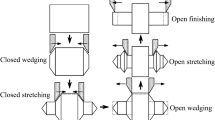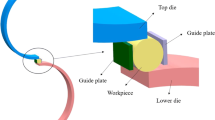Abstract
In this paper, a simulation model for two-roll cross wedge rolling (CWR) was presented to investigate the deformation mechanism for forming shafts without concavity by using the finite element method. Based on the simulation results, the reason for concavity in both sides of the rolled piece in the CWR process was analyzed in detail, and a method to implement the CWR process without loss of material was brought forward by billet compensation. In addition, the influence of the main process parameters on the concavity depth of the workpiece with a tapered or circular-arc end was compared and ascertained. The study results show that the concavity depth is in direct proportion to the cone angle, but in inverse proportion to the central angle, and the concavity can be improved with larger area reduction and mill length under the two profiled ends. Subsequently, the feasibility of using profiled billets to effectively control the concavity was verified via the rolling experiments.
Similar content being viewed by others
References
Yan HJ, Mao HE, Wang LJ, Liu YZ, Liu JP, Hu ZH (2012) Study on metal flow law in cross wedge rolling of trapezoidal helical tooth shaft. J Plastic Eng 19(5):20–24
Zhao R, Zhang KS, Hu ZH (2012) Different equations for solving shaping curve of inside right-angle steps in cross wedge rolling. Forg Stamp Technol 37(4):70–74 (in Chinese)
Yang CP, Hu ZH (2016) Research on the ovality of hollow shafts in cross wedge rolling with mandrel. Int J Adv Manuf Technol 83:67–76
Yang YM, Xiao B, Zhao J (2013) Feasibility study on cross wedge rolling forming for jaw crusher eccentric shafts. Hot Work Technol 42(15):115–121 (in Chinese)
Yan HJ, Ma SB, Han PB, He XX, Liu JP, Hu ZH (2014) Effect of process parameters on core quality of thread shaft rolling in cross wedge rolling. J Plastic Eng 39(3):62–66
Li N, Wang ZX, Yang KJ, Yu XL, Chen WZ (2015) Analysis on forming defects during asymmetric cross wedge rolling and determination of die parameters. J Mater Sci Eng 33(2):263–267
Huang HB, Chen X, Fan BB, Jin YC, Shu XD (2015) Initial billet temperature influence and location investigation on tool wear in cross wedge rolling. Int J Adv Manuf Technol 79:1545–1556
Zhou J, Xiao C, Yu YY, Jia Z (2013) Influence of tool parameters on tool wear in two-roll cross-wedge rolling. Int J Adv Manuf Technol 65:745–753
Wang MH, Xiang D, Xiao C, Zhou J, Jia Z (2012) Influence of cooling condition of tools on central deformation of workpiece and tool wear in cross wedge rolling. Int J Adv Manuf Technol 59:473–482
Liu YB, Chen WL, Zheng MY (2015) Forging process of improvement on wedge rolling with large cross-sectional area shrinkage. J Netshape Form Eng 7(4):11–16 (in Chinese)
Li Q, Lovell MR (2004) The establishment of a failure criterion in cross wedge rolling. Int J Adv Manuf Technol 24:180–189
Li N, Ge XM, Yang XY, Wang ZX (2015) Combined application of cross wedge rolling and die forging technology in shaft parts production. Hot Work Technol 44(17):115–117 (in Chinese)
Ji HC, Liu JP, Wang BY, Zhang ZR, Zhang T, Hu Z (2015) Numerical analysis and experiment on cross wedge rolling and forging for engine valves. J Mater Process Technol 221:233–242
Ma ZH, Yang CP, Hu ZH (2002) Study on effect factors of end concavity in cross wedge rolling. Forg Stamp Technol 27(1):29–31 (in Chinese)
Liu GH, Jiang Z, Xu CG, Ren GS (2010) Study on deformation principle to forming shafts without concavity during near net shape cross wedge rolling process. In: Special Rolling Academic Conference Proceedings, Kunming, China, pp 71-74:25–27
Shu XD, Li CB, Zu WM. Rolling method of no scrap shafts by cross wedge rolling: China Patent, 200910154327.3.2010–06-09 (in Chinese)
Zhu CB, Liu B. Special mold of rotary shafts without scrap by cross wedge rolling: China Patent, 201020103803.7.2010–09-29 (in Chinese)
Hu B, Shu XD (2014) On end quality for roll-cutting billet without stub bar in cross wedge rolling. J Ningbo Univ 27(3):103–107
Ma JD, Shu XD, Liu C (2015) Estimating criteria of roll-cutting blank end surface in cross wedge rolling without stub bar. Hot Work Technol 44(15):150–152 (in Chinese)
Yang G, Zhang KS, Duan WZ, Hu ZH (2014) Effect of process parameters on the end scrap of no-step-end workpieces by cross wedge rolling. J Univ Sci Technol Beijing 36(7):959–965
Peng WF, Zhang JH, Huang GX, Liu WP, Shu XD, Zhu J (2016) Stress distributions during the cross-wedge rolling of composite 42CrMo/Q235 laminated shafts. Int J Adv Manuf Technol 83:145–155
Author information
Authors and Affiliations
Corresponding author
Rights and permissions
About this article
Cite this article
Zeng, J., Xu, C., Ren, W. et al. Study on the deformation mechanism for forming shafts without concavity during the near-net forming cross wedge rolling process. Int J Adv Manuf Technol 91, 127–136 (2017). https://doi.org/10.1007/s00170-016-9742-6
Received:
Accepted:
Published:
Issue Date:
DOI: https://doi.org/10.1007/s00170-016-9742-6




